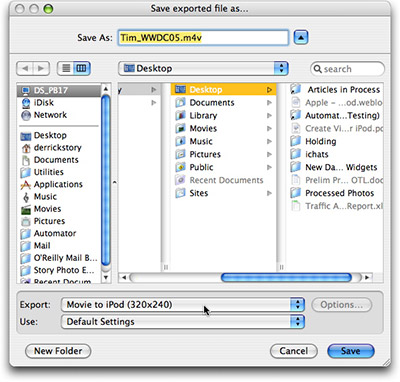Digital cameras have become adept at making movies as well as capturing still images. I've had great fun with the Casio EX-P505 that shoots amazing video using the M2S4 (MPEG-4) Codec. I get 30fps at 640x480 resolution and stereo audio. Many other cameras offer comparable specs too.
For some time now, we've been able to watch the movies we make with these cameras on our computers and even burn them to DVD for TV viewing. But as of Oct. 12, 2005, we can start thinking about carrying our videos around and sharing them with others on the new Apple iPod video that displays movies at 320x240 resolution in full stereo.
It's quite easy to prepare your movies for the iPod. Just download the latest version of QuickTime Pro (the player only version is free, but to edit and prepare content for the iPod you need the Pro version that costs $30) and open your home movie. Then go to File > Export... and select "Movie to iPod" from the drop down menu as shown below.

Open your movie in QuickTime Pro, then choose the "Movie to iPod" export option.
You should know that the ripping process is processor-intensive and will take your computer a while, so you might want to go grab some dinner while it prepares the movie. Once it has finished making your production iPod-frienndly, you can open iTunes 6 and drag the movie to the "Videos" folder in the left hand "Source" column. If you don't have iTunes 6 yet, you can download it for free. Now, when you connect your iPod video, it will automatically grab the movie you just loaded into the Video folder, and you can play it right alongside the latest episode of "Lost."
If you want more details, Apple has published a helpful tutorial titled, Creating Video for iPod.
Tips for Capturing Video with a Digital Camera
Here are a few tips to help you capture iPod-friendly video. There's also a helpful article on O'Reilly's Digital Media site by Ian David Aronson that provides additional hints.
- Shoot in good lighting. Video needs lots of light. If it's too dark inside, then go out, at least for your first project or two.
- Use a big memory card. Video takes up much more memory than still pictures. I recommend 1GB.
- Record at the highest quality and resolution possible. For example, if you camera supports 640x480 at 30fps, go for it.
- Get close. Compose your frame tightly. These movies will be viewed at 320x240, which isn't exactly movie theater size. So stay away from distance shots and get close to your subjects.
- Try to avoid too much background noise (audio). On-camera microphones tend to pick up *everything,* so try to control background noise best you can. And beware of wind! It sounds terrible.
- Figure out what you're going to shoot before you press the record button. You don't have to have a full blown storyboard, but sketch out your scenes beforehand.
- Keep your movies to 5 minutes or less. You have a better chance of holding your audience's attention.
Listen to the Podcast
Now that you have your gear together, it's time to listen to today's audio show title, "Making Movies with Digital Cameras." You can download the podcast here (23 minutes). And for a real treat, I've posted a sample movie titled, The Potting Bench. It's iPod ready now.












Derrick, I liked your "Potting Shed" video - it was a good illustration of how a short video could be organized. I haven't listened to your podcast yet - I plan on doing that a little later. I went to emonkid's site and found that he has included a link from 8/2005 for Casio's own download for converting Exilum Mpeg-4 to AVI. Which download do you think is better?
Your digital photography book came in yesterday's mail - I'm taking my new Casio Ex-Z750 to a family reunion this weekend and your book will go right in the bag along side it.
Casio's QuickTime Plug-In vrs Emonkid's
Both are good, and from what I've heard, you might as well download the MPEG-4 plug-in on Casio's site. I talked to emonkid about it, and he says it works great. I'm still using the open source plug-in that emonkid wrote because it works fantastic, and I have no reason to change. I guess, if you run into problems with one, you can always switch to the other.
As for The Potting Bench, thanks for the nice comment :)
And finally, Virginia mentioned that she bought the latest version of my Digital Photography Pocket Guide. I want to let all TDS readers know that if you send me a mailing address, I'll send you a signed author's plate for your book. You can send your request to derrick@thedigitalstory.com. Thanks Virginia!
thx for the information necessary to me.. and no comments (c)
http://tire.alltradein.com
..and nice site for auto dialers! :) thx!